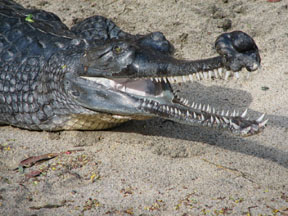WEAKENED JAWS
--Shivani Thakur
Legend has it that when a ghariyal caught hold of the foot of an elephant,
Lord Vishnu with his sudershan chakra could only save.it,
from its powerful teeth. Alas these strong jaws are unable to save it from extinction. In its annual Red list of threatened species, published this year by the World Conservation Union (IUCN) the ghariyal has been up listed from “endangered”
to “critically endangered. There are now only 200 breeding adults’ left in the wild.

Usually found in Indus, Brahmputra, Ganga and Mahanadi river systems it is adapted to calmer waters of deep rivers. These animals are slow on land and come to sandbanks
to bask in the sun or lay eggs. Unlike other crocodiles the ghariyals have a long snout with a bulbous tip on the males resembling a pot or ‘ghara’. It has razor sharp teeth for eating fish. The ghariyal is one of the largest species
of crocodiles comparing to the Nile crocodile. It can reach the length of 5 meters, sometimes even 6 meters. The young ones eat larvae, insects, and frogs. However adults are mainly fish eaters and sometimes scavenge on dead animals. Breeding begins in the
winter months of November, December and January; nesting is in the dry season of March, April and May. They lay about 30 to 50 eggs, which hatch in about 80 to 90 days. The eggs are laid in sandbanks by digging the soil and covering it from predators.
In 1970 the ghariyal population had declined to its lowest levels but a Project Ghariyal was started which brought its wild numbers to 400 in 1997. Deemed a success it was stopped.
According to IUCN the numbers have dwindled to 186 in 2006 almost half the population lost in a decade. The ghariyal faces threat from fishing and illegal activities such as sand mining that destroys their nests.
Its eggs are collected for medicinal purposes and the snout is thought to have aphrodisiac qualities. The croc skin is used in making bags and shoes.
The decline in population of fish which is its diet also one of the cause.

Dr.Sandeep Behra, who heads the WWF’s ghariyal conservation program is amember of the Ghariyal Multi Task Force set up to assess population trends and avert its eventual extinction in the wild. In India, the breeding population of the ghariyal is found
in two sites –the Chambal and a five km stretch of the Girwa River in Katerniaghat Wildlife Sanctuary on the Indo-Nepal border. It was in the Chambal Sanctuary that the Project Crocodile was the focus of intense conservation.
The ghariyal is not seen as an animal making much of a difference in our environment but it helps in keeping control of fish population.
An animal, which has survived from the time of dinosaurs, deserves its place on earth.
( Photograph of ghariyal from Chambal, courtesy MP Tourism; Photograph of the male’s ”ghara’ from wikipedia).